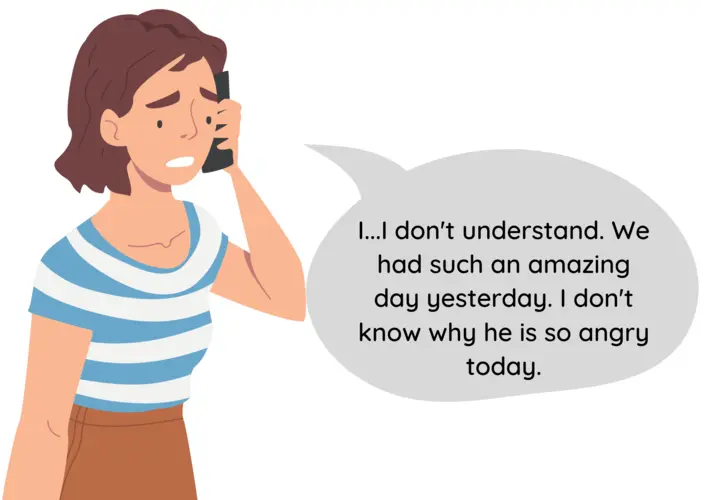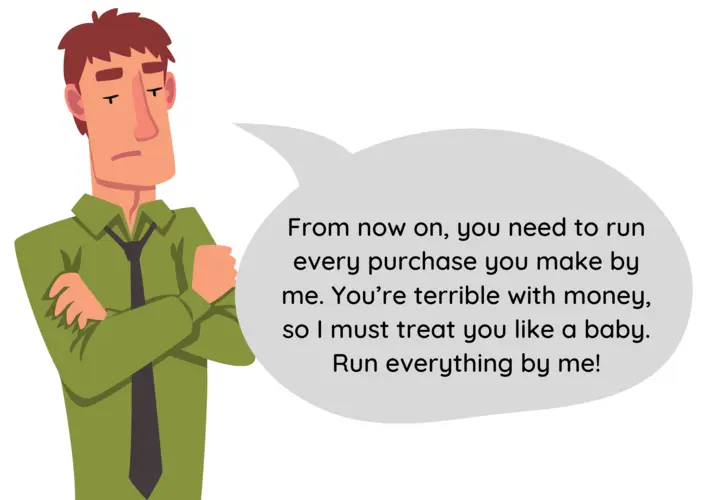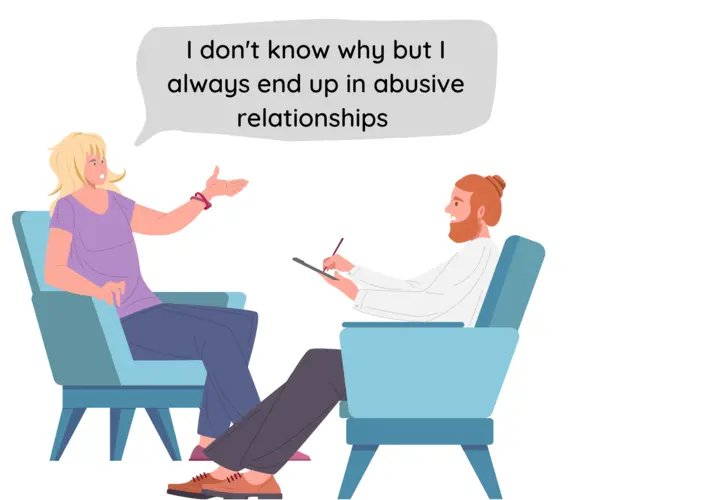We got an interesting question from our community members during our workshop about trauma bonding: “What are the most common causes of trauma bonding?”
A survey of 1,000 of our community members revealed the most common causes of trauma bonding are receiving inconsistent positive and negative reinforcement, being in a relationship with significant power imbalances, being isolated from friends and family, having a history of trauma, and having low self-esteem.
In this article, I will guide you through these common causes to help you better understand the different reasons trauma bonds form.
1.) Receiving Inconsistent Positive and Negative Reinforcement
Intermittent reinforcement refers to the delivery of a reward at irregular intervals (receiving inconsistent positive and negative reinforcement).
In the context of an abusive relationship, the abuser will unpredictably alternate between periods of kindness, affection, and abuse.
For example, the abuser might be kind and loving one day and suddenly become abusive and punishing the next without any apparent reason or trigger.

After a period of abuse, the abuser may switch back to being kind and affectionate, causing tremendous confusion in the target.
This unpredictability creates a roller coaster of emotions for the target, leading to a constant state of anxiety, insecurity, and instability.
Over time, the target becomes dependent on the moments of “kindness” and “affection” from the abuser because they provide stability, validation, and relief.
This is how the trauma bond is formed, but there is more…
Suggested Reading: Why Do Trauma Bonds Feel Like an Addiction?
Over time, the target may start to rationalize or minimize the abuse.
Convincing themselves that the abuser’s affectionate moments are a sign of their true feelings and that the abuse is just a temporary lapse or a result of external stressors.
This rationalization/minimization strengthens the trauma bond and makes the target increasingly dependent on the abuser for stability, validation, and relief.
2.) Being in a Relationship with Significant Power Imbalances
Power imbalances occur when one person in a relationship holds significantly more power, control, or influence over the other person.
This can happen in various ways, such as one person having more financial resources, having a higher social status, being more emotionally stable, etc.
In an abusive relationship, abusers often use power imbalances to exert control over their target.
For example, the abuser may use their financial resources to control the target’s access to money or use their physical strength to intimidate the target.

This power imbalance can cause the target to feel trapped in the relationship, as they may feel they have no other options or are incapable of taking care of themselves.
The target may start to view the abuser as a protector or provider despite the abuse.
Over time, this dynamic can create a strong trauma bond between the target and the abuser, as the target becomes increasingly reliant on the abuser for their well-being.
3.) Experiencing Isolation from Friends and Family
Isolation is a common tactic used by abusers to gain control over their targets.
Suggested Reading: 5 Ways That Narcissists Isolate You
This involves cutting the target off from their support network, such as friends and family, and controlling their interactions with others.
The abuser may use various tactics to do this, such as creating conflicts between the target and their loved ones or manipulating the target’s perception of others.
By isolating the target, the abuser increases the target’s dependence on them, as they become the only source of social interaction and support.
This can lead to the target feeling the abuser is the only person they can rely on, creating a trauma bond.
Additionally, the lack of outside perspectives may cause the target to normalize the abuse or lead them to believe it is their fault, strengthening the trauma bond.
4.) Having a History of Previous Traumatic Experiences
Previous experiences of trauma, such as childhood abuse or past abusive relationships, can lead to the formation of trauma bonds.
This is because when an individual experiences trauma, their understanding of love and care often becomes intertwined with abusive behavior.
You see, in their past, the people who were supposed to provide love, care, and protection were the same people who inflicted harm.
Experiencing this creates a confusing association between affection and abuse.
As a result, the individual may subconsciously seek relationships that mirror this dynamic, as it feels familiar and comforting.

They may not consciously recognize the behavior they are experiencing is abusive because, again, in their past, abuse was normalized as a part of being cared for.
This leads to the formation of a trauma bond, where the target becomes emotionally attached to the abuser despite the abusive behavior.
That’s not all…
This learned association can cause the individual to misinterpret abusive behavior as a sign of affection or attention.
For example, if an abuser exhibits jealousy or possessiveness, the target may interpret this as a sign that the abuser cares about them rather than as a form of control.
This further reinforces the trauma bond, as the target may feel validated and cared for by the abuser despite the harm they are causing.
5.) Having Low Self-Esteem
When someone has low self-esteem, they often feel bad about themselves and believe they do not deserve to be treated well.
This can make them more likely to accept bad treatment from others because they think poor treatment is all they deserve.
Suggested Reading: 10 Ways to Build Self-Esteem After Narcissistic Abuse
An abuser could take advantage of this by giving the person with low self-esteem some approval and then taking it away (intermittent reinforcement).
This can make the person feel like they need the abuser’s approval to feel good about themselves, which lays the groundwork for forming a trauma bond.
As the abusive relationship progresses, the person with low self-esteem could become emotionally attached to the abuser, even though the abuser is hurting them.
This is because they might see the abuser as the only one who will be with them, given how poorly they think of themselves.
This emotional attachment is a key part of the trauma bond, making it very hard for the person to leave the relationship.
What Should You Take Away from This Article?
I want to thank all of our community members for participating in this survey and you, the reader, for taking the time to read this article.
I hope it brought you value and gave you a better understanding of the different causes of trauma bonding.
Suggested Reading: How to Break a Trauma Bond with a Narcissist in 11 Steps
About the Author

Hey, I’m Elijah.
I experienced narcissistic abuse for several years and was shocked by just how common it is. I create these articles to spread awareness.
But I’m not alone—there are many others here at Unfilteredd, all dedicated to helping people like you live a life free from the effects of narcissistic abuse.
If you’d like to learn more about how we can help, please click the button below.
